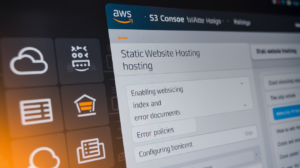Ever tried explaining DNS to someone and watched their eyes glaze over faster than a donut at Krispy Kreme? You’re not alone. Most tech explanations make DNS sound like rocket science when it’s actually the internet’s phone book.
When you type “netflix.com” into your browser, DNS servers are the behind-the-scenes heroes translating that human-friendly name into the numerical IP address computers actually understand.
In this no-fluff guide, we’ll demystify how DNS works by breaking down root servers, TLDs, and authoritative name servers in plain English. No computer science degree required.
But here’s what nobody tells you about DNS – understanding it isn’t just for IT pros. It’s the secret weapon for diagnosing weird connection issues when your favorite sites suddenly stop working.
DNS Fundamentals Explained Simply
A. What DNS Actually Does for You
DNS is your internet phonebook. When you type “facebook.com” in your browser, you’re not typing an address—you’re typing a name. Your computer has no idea where “facebook.com” is located on the internet.
That’s where DNS steps in. It takes that human-friendly domain name and converts it to an IP address like 157.240.22.35—the actual location computers understand. Without DNS, you’d need to memorize dozens of number sequences just to check your email or scroll through social media.
DNS saves you from the nightmare of remembering numeric addresses for every website you visit. It handles billions of these translations every day, completely behind the scenes.
B. How DNS Translates Domain Names to IP Addresses
The translation process happens lightning-fast:
- You type “amazon.com” in your browser
- Your computer checks if it already knows the IP address
- If not, it asks a DNS resolver (usually at your ISP)
- The resolver works through a hierarchy of servers to find the answer
- It starts with root servers, then moves to top-level domain servers (.com)
- Finally, it reaches the authoritative server that knows exactly where amazon.com lives
- The IP address gets sent back to your browser
- Your browser connects to that IP address
This entire process typically takes milliseconds, which is why you rarely notice it happening.
C. The Critical Role of DNS in Your Daily Browsing
DNS is the silent hero of your internet experience. Without it:
- Links wouldn’t work (they use domain names)
- Email would break (addresses use domains)
- Apps couldn’t connect to their servers
- Cloud services would be inaccessible
DNS also provides redundancy. Popular websites are often hosted on multiple servers with different IP addresses. DNS can direct you to the closest or least busy server, ensuring websites load quickly.
It’s also your security gatekeeper. Many security tools use DNS to block malicious websites before your browser even connects to them.
D. Why Understanding DNS Improves Your Internet Experience
Knowing how DNS works gives you real advantages:
- Troubleshooting connection problems becomes easier (is it DNS or something else?)
- You can switch to faster DNS providers like Cloudflare or Google for speedier browsing
- You’ll understand why some websites load instantly while others take seconds
- You can better protect yourself from DNS-based attacks and privacy issues
DNS knowledge also helps you make sense of other internet concepts. It’s like knowing how roads connect—once you understand the system, navigating becomes intuitive.
The next time a website seems slow, you might consider whether it’s a DNS issue rather than blaming your internet connection entirely.
Root Servers: The Foundation of DNS
What Root Servers Are and Their Global Distribution
Ever wondered who sits at the very top of the DNS food chain? That’s right – root servers.
These aren’t physical servers you can point to and say “that’s a root server.” They’re actually systems – 13 of them to be exact – distributed across hundreds of locations worldwide. Each system is operated by different organizations and identified by letters A through M.
Why spread them around the globe? Simple – reliability and speed. If all root servers were in one location, a natural disaster or power outage could bring the entire internet to its knees. Plus, having servers closer to users means faster response times.
Today, there are over 1,000 root server instances scattered across every continent (yes, even Antarctica has one!). These aren’t just concentrated in tech hubs like Silicon Valley – they’re strategically positioned to serve users everywhere from Tokyo to Timbuktu.
How Root Servers Begin the DNS Resolution Process
When you type a website address, your journey starts with root servers.
Think of them as the internet’s ultimate phone book – they don’t know specific addresses, but they know who to ask next.
The process goes something like this:
- Your computer asks: “Where’s example.com?”
- Your DNS resolver says: “No idea, let me ask a root server”
- The root server responds: “I don’t know exactly, but check with the .com TLD servers”
Root servers don’t store all domain information – that would be impossible! They just point to the next step in the chain, the Top-Level Domain (TLD) servers.
This might seem inefficient, but it’s actually brilliant. By distributing the load, no single system gets overwhelmed.
The 13 Logical Root Server Systems Explained
The internet runs on just 13 root server systems. Sounds crazy, right?
Each system (labeled A through M) consists of multiple physical servers using anycast routing – a clever trick that directs your query to the nearest server instance.
Here’s a quick breakdown:
| Root Server | Operator | Number of Locations |
|---|---|---|
| A | Verisign | 155+ |
| B | USC-ISI | 1 |
| C | Cogent | 9 |
| F | Internet Systems Consortium | 241+ |
| J | WIDE Project | 115+ |
The most widely distributed is the F-root system with instances in over 240 locations worldwide.
These systems handle millions of queries every second without breaking a sweat. And despite occasional DDoS attacks targeting them, the redundancy built into the system ensures the internet keeps humming along.
The root server system hasn’t changed much since the early days of the internet – proof that some designs are just too good to mess with.
Top-Level Domain (TLD) Servers Demystified
A. Common TLDs You Encounter Daily (.com, .org, .net)
You’ve seen them everywhere – those little endings after domain names. The .com, .org, .net that finish off website addresses. These are Top-Level Domains (TLDs), and they’re not just random letters.
.com domains rule the internet. Originally meant for “commercial” entities, now everyone wants one. They’re the internet’s prime real estate.
.org was created for organizations and non-profits. Think Wikipedia.org or RedCross.org – they signal a mission beyond making money.
.net was designed for network providers but has become a popular alternative when the .com version is taken.
When you type these into your browser, your request gets sent to specific TLD servers that know exactly where to point you.
B. Country-Code TLDs and Their Specific Uses
Country-code TLDs (ccTLDs) are two-letter codes tied to specific countries. Some examples:
- .uk (United Kingdom)
- .ca (Canada)
- .jp (Japan)
- .de (Germany)
- .au (Australia)
These aren’t just for show. Many businesses use them to target specific geographic markets. A .de domain instantly signals to German users that the site is for them.
Some countries have turned their ccTLDs into businesses. The tiny island of Tuvalu (.tv) makes millions licensing their domain for television-related websites. Montenegro (.me) markets their domain for personal websites.
C. New gTLDs and How They’ve Expanded the Internet
The internet was bursting at the seams with the limited TLD options. So in 2012, ICANN opened the floodgates with new generic TLDs (gTLDs).
Now we have:
- .app for mobile applications
- .shop for e-commerce stores
- .blog for bloggers
- .photography for photographers
- .tech for technology companies
This expansion created millions of new domain possibilities. Before, if example.com was taken, you were mostly out of luck. Now you could grab example.photography or example.tech instead.
D. How TLD Servers Direct Your Web Requests
TLD servers are like the middle managers of the internet. When you type a domain name:
- Root servers first direct your request to the appropriate TLD server
- The TLD server holds information about all domains registered under it
- It checks its database for your specific domain
- Then points your request to the authoritative name server for that domain
This all happens in milliseconds. The TLD server doesn’t know exactly where your website is – it just knows who does know.
E. The Organizations Managing Different TLDs
Different TLDs have different landlords:
- .com and .net are managed by Verisign
- .org is handled by Public Interest Registry
- ccTLDs are typically managed by organizations within their respective countries
- New gTLDs are operated by various registries that applied and paid for the right
ICANN (Internet Corporation for Assigned Names and Numbers) oversees this entire ecosystem. They decide which TLDs exist and who gets to manage them.
These organizations set the rules and prices for registering domains under their TLDs. That’s why some domains cost $10/year while others might cost thousands.
Authoritative Name Servers and Their Critical Function
How These Servers Store Your Domain’s DNS Records
Think of authoritative name servers as the keepers of truth for your domain. When you register a domain like “yourawesomesite.com,” these servers store all the DNS records that tell the world how to find your website.
What records are we talking about? The most common ones include:
- A Records: Point your domain to an IP address (like 192.168.1.1)
- CNAME Records: Create aliases (so blog.yourdomain.com points to yourdomain.com)
- MX Records: Direct email to the right servers
- TXT Records: Store text information (often used for verification)
These records aren’t just randomly scattered around. They’re organized in what’s called a “zone file” – basically a database of all your domain’s DNS information.
The Difference Between Primary and Secondary Authoritative Servers
Primary (master) and secondary (slave) servers aren’t just fancy names – they serve distinct purposes:
| Primary Server | Secondary Server |
|---|---|
| Holds the original zone file | Maintains copies of the zone file |
| Where changes are made first | Gets updates from the primary server |
| Can be a single point of failure | Provides redundancy if primary fails |
Your domain typically has multiple authoritative servers for a good reason. If one goes down, the others keep your website accessible. It’s like having backup keys to your house – you hope you never need them, but you’re glad they exist.
How Authoritative Servers Provide the Final Answer
The DNS lookup process is like a scavenger hunt, and authoritative servers provide the treasure at the end.
When someone types your domain in their browser, the request bounces from recursive resolvers to root servers to TLD servers. Finally, it reaches your authoritative servers, which say, “Yes, I know exactly where that website is!” and provide the IP address.
What makes authoritative servers special is their definitiveness. Unlike caching servers that might have outdated information, authoritative servers always have the current, correct data for your domain. They’re the final word.
Setting Up Your Own Domain’s Authoritative Records
Getting your DNS records right isn’t rocket science, but it matters. Here’s how to handle it:
- Through your domain registrar: Most registrars (GoDaddy, Namecheap, etc.) provide a dashboard to manage DNS records
- Using DNS hosting services: Companies like Cloudflare and Amazon Route 53 offer advanced DNS management
- Self-hosting: For the brave, you can run your own DNS server (using software like BIND)
The most important thing? Keep your TTL (Time To Live) values reasonable. Too short and you’ll overload your servers; too long and changes take forever to propagate.
When making changes to critical DNS records, start by lowering the TTL values 24-48 hours beforehand. This ensures your changes spread quickly when you’re ready to go live.
The Complete DNS Resolution Process in Action
Step-by-Step Walkthrough of a DNS Query
Ever wonder what happens when you type a website address into your browser? It’s not magic—it’s DNS in action!
When you enter “www.example.com” in your browser, your computer needs to find the actual IP address where that website lives. Here’s the journey your request takes:
- Your browser first checks its own cache: “Do I already know this address?”
- If not, it asks your operating system: “Have you seen this before?”
- Still no luck? Your request goes to your recursive DNS resolver (usually your ISP’s server)
- The resolver starts at the root DNS servers, which point to the right TLD servers
- The TLD servers (like .com managers) direct to the authoritative name servers
- These authoritative servers finally provide the IP address for example.com
- Your browser stores this information and connects to the website
This whole process typically happens in milliseconds! Pretty impressive considering your request might bounce between multiple servers across the globe.
How DNS Caching Speeds Up Your Browsing
DNS caching is the internet’s way of saying, “I’ll remember that for next time.”
Without caching, you’d perform this lookup dance every single time you visited a website. Talk about inefficient! Instead, DNS information gets stored at multiple levels:
- Browser cache: Chrome, Firefox, and other browsers keep their own DNS records
- Operating system cache: Windows, macOS, and Linux maintain a system-wide cache
- Router cache: Your home network equipment stores DNS info
- ISP cache: Your internet provider keeps popular lookups handy
These caches dramatically cut down lookup times. The first visit to a website might take 20-120 milliseconds for DNS resolution, but subsequent visits could drop to under 1ms!
Each cached record comes with a TTL (Time To Live) value—basically an expiration date. This ensures you eventually get updated information when websites change their hosting.
Troubleshooting Common DNS Issues You Might Face
DNS problems can make it seem like the internet is broken. Here are the usual suspects:
Can’t access any websites? Your DNS resolver settings might be incorrect. Try changing to Google’s public DNS (8.8.8.8) or Cloudflare’s (1.1.1.1).
Some sites work but others don’t? This often means a DNS cache problem. Flush your DNS cache:
- Windows: Run
ipconfig /flushdnsin Command Prompt - Mac: Enter
sudo killall -HUP mDNSResponderin Terminal
Website changed servers but you’re still seeing the old version? Your cache likely has outdated information. Clear browser cache or wait for the TTL to expire.
Slow browsing experience? Your DNS resolver might be underperforming. Benchmark different DNS providers to find faster options.
Remember: most DNS issues can be solved by clearing caches or changing DNS servers!
DNS Security Concerns You Should Be Aware Of
DNS wasn’t built with security in mind, and attackers know it. Here’s what to watch for:
DNS Spoofing/Cache Poisoning: Attackers insert fake DNS records, redirecting you to malicious sites. This is why DNSSEC was developed—it adds digital signatures to DNS data.
DNS Hijacking: Someone changes your DNS settings without permission. Always check your network settings if browsing behavior suddenly changes.
DNS Amplification Attacks: Hackers use DNS servers as unwitting accomplices in DDoS attacks, flooding targets with massive amounts of DNS response traffic.
DNS Tunneling: Sneaky hackers can hide other traffic inside DNS queries to bypass firewalls.
Protect yourself by:
- Using secure DNS providers that support DNS-over-HTTPS or DNS-over-TLS
- Keeping your devices and routers updated
- Being suspicious if you’re suddenly redirected to unfamiliar websites
- Setting up DNSSEC validation where possible
DNS security isn’t just for tech experts—it affects everyone who uses the internet. And that’s pretty much all of us!
DNS is the internet’s addressing system, translating human-friendly domain names into machine-readable IP addresses. This essential service operates through a hierarchical structure that begins with Root servers at the top, flows through Top-Level Domain (TLD) servers in the middle, and ends with Authoritative Name servers that store specific domain information. Understanding how these three server types work together helps clarify how your browser finds websites when you type in a URL.
Next time you visit a website, remember the sophisticated DNS resolution process happening behind the scenes. This invisible infrastructure ensures you reach your intended destination within milliseconds, despite the internet’s vast complexity. Whether you’re a website owner or simply an internet user, this knowledge empowers you to better understand the digital world and potentially troubleshoot connection issues when they arise.




















